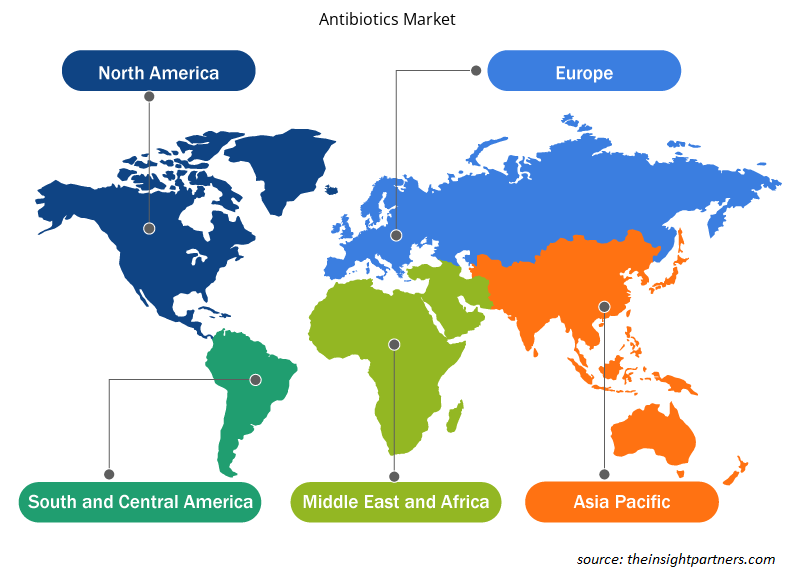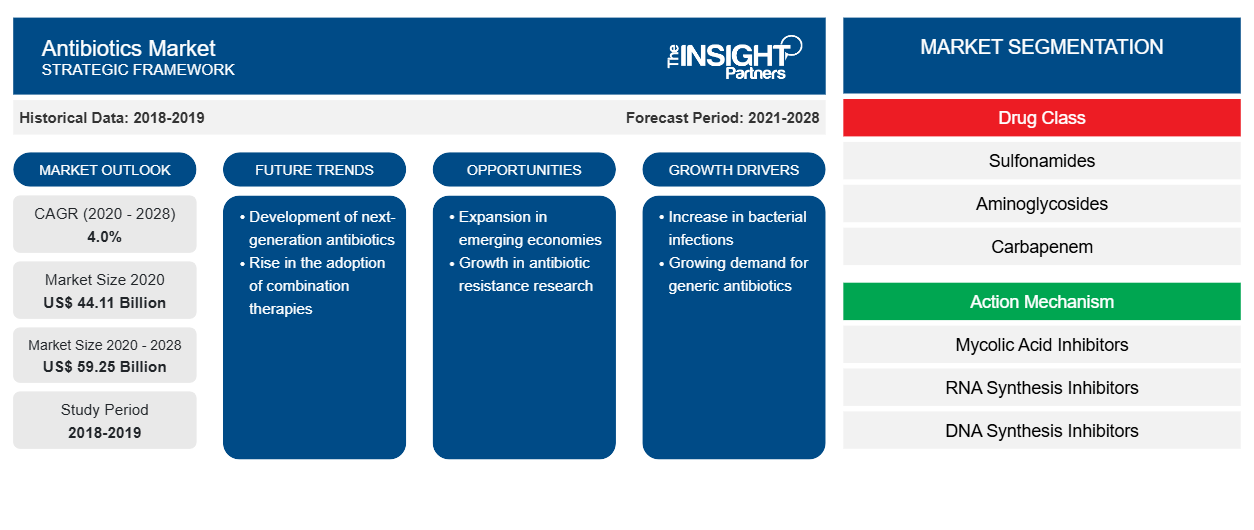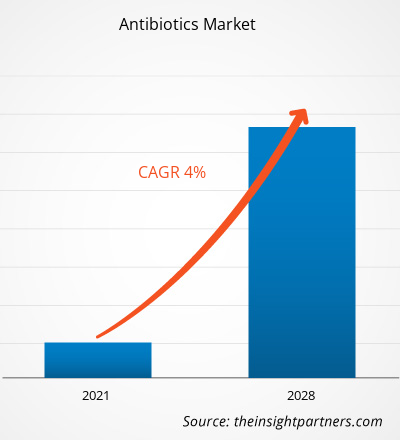Der Antibiotikamarkt wurde im Jahr 2020 auf 44.111,31 Millionen US-Dollar geschätzt und soll im Jahr 2028 59.253,24 Millionen US-Dollar erreichen; für den Zeitraum 2021–2028 wird ein durchschnittliches jährliches Wachstum von 4,0 % erwartet.
Antibiotika sind wirksame Medikamente zur Bekämpfung bakterieller Infektionen und Erkrankungen. Sie werden insbesondere zur Behandlung von Infektionen eingesetzt, die durch Bakterien wie Staphylokokken, Streptokokken oder E. coli verursacht werden . Antibiotika töten die Bakterien entweder ab (bakterizid) oder verhindern ihre Vermehrung und ihr Wachstum ( bakteriostatisch ). Die auf dem Markt erhältlichen Antibiotika wirken nicht gegen Virusinfektionen. Einige der häufigsten Infektionen, die mit Antibiotika behandelt werden, sind Konjunktivitis, Haut- oder Weichteilinfektionen, Infektionen der oberen Atemwege, Bronchitis, Streptokokken-Pharyngitis (Streptokokken-Angina) und andere.
Markteinblicke
Zunehmende Entwicklung von Generika
Ein Generikum ist eine Kopie eines Markenmedikaments, das nicht mehr patentgeschützt ist. Generika werden auf den Markt gebracht, um kostengünstige Medikamente anzubieten und diese Medikamente für Menschen verschiedener wirtschaftlicher Schichten zugänglich zu machen. Generika sind aufgrund ihrer Verfügbarkeit und Erschwinglichkeit beliebt. Laut einer 2018 im NCBI veröffentlichten Studie war der durchschnittliche Preis für verschreibungspflichtige Markenmedikamente beispielsweise fast viermal so hoch wie der durchschnittliche Preis für Generika. Darüber hinaus konzentrieren sich die Unternehmen auch auf die Entwicklung von Generika mit dem Ziel, Antibiotika zu minimalen Kosten anzubieten. Im Juni 2018 brachte Lupin beispielsweise eine generische Tobramycin- Inhalationslösung auf den US-Markt. Darüber hinaus wird erwartet, dass die Förderung durch Regierungsbehörden die Produktion generischer Antibiotika vorantreibt, was im Prognosezeitraum letztendlich das Wachstum des Antibiotikamarktes vorantreiben wird. Im Februar 2019 gab die US-amerikanische Food and Drug Administration (FDA) beispielsweise die Zulassung zur Vermarktung von Generika bekannt, die von indischen Pharmaunternehmen in den USA hergestellt werden.
Passen Sie diesen Bericht Ihren Anforderungen an
Sie erhalten kostenlos individuelle Anpassungen an jedem Bericht, einschließlich Teilen dieses Berichts oder einer Analyse auf Länderebene, eines Excel-Datenpakets sowie tolle Angebote und Rabatte für Start-ups und Universitäten.
- Holen Sie sich die wichtigsten Markttrends aus diesem Bericht.Dieses KOSTENLOSE Beispiel umfasst eine Datenanalyse von Markttrends bis hin zu Schätzungen und Prognosen.
Erkenntnisse zum Testtyp
Basierend auf der Arzneimittelklasse ist der Antibiotikamarkt in Sulfonamide, Aminoglykoside, Carbapeneme, Makrolide, Fluorchinolone, Penicillin, Cephalosporine und andere unterteilt. Das Cephalosporinsegment hatte im Jahr 2020 den größten Marktanteil, während das Fluorchinolonesegment im Prognosezeitraum voraussichtlich die höchste durchschnittliche jährliche Wachstumsrate auf dem Markt verzeichnen wird.aminoglycosides, carbapenem, macrolides, fluoroquinolones, penicillin, cephalosporin, and others. The cephalosporin segment held the largest share of the market in 2020; whereas the fluoroquinolones segment is anticipated to register the highest CAGR in the market during the forecast period.
Einblicke in Aktionsmechanismen
Basierend auf dem Wirkungsmechanismus wurde der Antibiotikamarkt in Mykolsäurehemmer, RNA-Synthesehemmer, DNA-Synthesehemmer, Proteinsynthesehemmer und Zellwandsynthesehemmer segmentiert. Das Segment der Zellwandsynthesehemmer hatte im Jahr 2020 den größten Marktanteil, während das Segment der DNA-Synthesehemmer im Prognosezeitraum voraussichtlich die höchste durchschnittliche jährliche Wachstumsrate (CAGR) auf dem Markt verzeichnen wird.
Unternehmen verfolgen häufig Strategien zur Produkteinführung und Zulassung, um ihre Präsenz und ihr Produktportfolio weltweit zu erweitern und der steigenden Nachfrage gerecht zu werden.
Die auf dem Antibiotikamarkt tätigen Marktteilnehmer verfolgen eine Expansionsstrategie, um ihren Kundenstamm weltweit zu vergrößern, was es den Akteuren auch ermöglicht, ihren Markennamen weltweit zu behaupten. So hat beispielsweise ein Unternehmen wie Pfizer im Juli 2019 ein internationales Forschungskonsortium ins Leben gerufen, um in Zusammenarbeit mit acht Biotechnologiepartnern und europäischen Wissenschaftlern neue TB-Antibiotika zu entdecken und zu entwickeln.
Regionale Einblicke in den Antibiotikamarkt
Die regionalen Trends und Faktoren, die den Antibiotikamarkt im Prognosezeitraum beeinflussen, wurden von den Analysten von Insight Partners ausführlich erläutert. In diesem Abschnitt werden auch die Antibiotikamarktsegmente und die Geografie in Nordamerika, Europa, im asiatisch-pazifischen Raum, im Nahen Osten und Afrika sowie in Süd- und Mittelamerika erörtert.

- Holen Sie sich die regionalen spezifischen Daten für den Antibiotika-Markt
Umfang des Marktberichts über Antibiotika
| Berichtsattribut | Details |
|---|---|
| Marktgröße im Jahr 2020 | 44,11 Milliarden US-Dollar |
| Marktgröße bis 2028 | 59,25 Milliarden US-Dollar |
| Globale CAGR (2020 - 2028) | 4,0 % |
| Historische Daten | 2018-2019 |
| Prognosezeitraum | 2021-2028 |
| Abgedeckte Segmente | Nach Arzneimittelklasse
|
| Abgedeckte Regionen und Länder | Nordamerika
|
| Marktführer und wichtige Unternehmensprofile |
|
Marktteilnehmerdichte: Der Einfluss auf die Geschäftsdynamik
Der Antibiotikamarkt wächst rasant, angetrieben durch die steigende Endverbrauchernachfrage aufgrund von Faktoren wie sich entwickelnden Verbraucherpräferenzen, technologischen Fortschritten und einem größeren Bewusstsein für die Vorteile des Produkts. Mit steigender Nachfrage erweitern Unternehmen ihr Angebot, entwickeln Innovationen, um die Bedürfnisse der Verbraucher zu erfüllen, und nutzen neue Trends, was das Marktwachstum weiter ankurbelt.
Die Marktteilnehmerdichte bezieht sich auf die Verteilung der Firmen oder Unternehmen, die in einem bestimmten Markt oder einer bestimmten Branche tätig sind. Sie gibt an, wie viele Wettbewerber (Marktteilnehmer) in einem bestimmten Marktraum im Verhältnis zu seiner Größe oder seinem gesamten Marktwert präsent sind.
Die wichtigsten auf dem Antibiotikamarkt tätigen Unternehmen sind:
- Pfizer, Inc
- Johnson & Johnson Services, Inc. (Janssen Pharmaceuticals),
- Abbott,
- GlaxoSmithKline Plc,
- Sanofi,
Haftungsausschluss : Die oben aufgeführten Unternehmen sind nicht in einer bestimmten Reihenfolge aufgeführt.

- Überblick über die wichtigsten Akteure auf dem Antibiotika-Markt
Globaler Antibiotikamarkt – nach Arzneimittelklasse
- Cephalosporin
- Penicillin
- Fluorchinolone
- Makrolide
- Carbapenem
- Aminoglykoside
- Sulfonamide
- Sonstiges
Globaler Antibiotikamarkt – nach Wirkmechanismus
- Inhibitoren der Zellwandsynthese
- Proteinsynthesehemmer
- Inhibitoren der DNA-Synthese
- Inhibitoren der RNA-Synthese
- Mykolsäurehemmer
- Sonstiges
Globale Antibiotika – nach Geografie
Nordamerika
- UNS
- Kanada
- Mexiko
Europa
- Frankreich
- Deutschland
- Italien
- Vereinigtes Königreich
- Spanien
- Restliches Europa
Asien-Pazifik (APAC)
- China
- Indien
- Südkorea
- Japan
- Australien
- Restlicher Asien-Pazifik-Raum
Naher Osten und Afrika (MEA)
- Südafrika
- Saudi-Arabien
- Vereinigte Arabische Emirate
- Restlicher Naher Osten und Afrika
Südamerika
- Brasilien
- Argentinien
- Restliches Südamerika
Firmenprofile
- Pfizer, Inc
- Johnson & Johnson Services, Inc. (Janssen Pharmaceuticals),
- Abbott,
- GlaxoSmithKline Plc,
- Sanofi,
- Novartis AG,
- Bayer AG,
- Bristol Myers Squibb Company,
- Eli Lilly und Company,
- Astellas Pharma
- Historische Analyse (2 Jahre), Basisjahr, Prognose (7 Jahre) mit CAGR
- PEST- und SWOT-Analyse
- Marktgröße Wert/Volumen – Global, Regional, Land
- Branche und Wettbewerbsumfeld
- Excel-Datensatz



Report Coverage
Revenue forecast, Company Analysis, Industry landscape, Growth factors, and Trends

Segment Covered
This text is related
to segments covered.

Regional Scope
North America, Europe, Asia Pacific, Middle East & Africa, South & Central America

Country Scope
This text is related
to country scope.
Häufig gestellte Fragen
Antibiotics are powerful medicines that are used to fight against bacterial infections. Antibiotics are also known as antibacterials which include a range of powerful drugs and are used to treat diseases caused by bacteria. These are specifically used to treat infections caused by bacteria such as, Staph., Strep., or E. coli. and either kill the bacteria (bactericidal) or keep it from reproducing and growing (bacteriostatic). The antibiotics do not work against any viral infection. Some common infections treated with antibiotics are, conjunctivitis, skin or soft tissue infection, upper respiratory tract infection, bronchitis, streptococcal pharyngitis (strep throat) and among others.
The North American region holds the largest market for the breast cancer screening. The United States held the largest market for antibiotics market and is expected to grow due to factors such as increasing number of rising in prevalence of breast cancer , growing developments for screening and imaging process by the companies and others.
The growth of the market is attributed to some key driving factors such as rising prevalence of bacterial infections, growing geriatric population and increasing development of generic drugs. However, tedious and expensive process of antibiotic development is expected to restraint the growth of the market during the forecast years.
Trends and growth analysis reports related to Life Sciences : READ MORE..
The List of Companies - Antibiotics Market
- Pfizer, Inc
- Johnson & Johnson Services, Inc. (Janssen Pharmaceuticals),
- Abbott,
- GlaxoSmithKline Plc,
- Sanofi,
- Novartis AG,
- Bayer AG,
- Bristol Myers Squibb Company,
- Eli Lilly and Company,
- Astellas Pharma
The Insight Partners performs research in 4 major stages: Data Collection & Secondary Research, Primary Research, Data Analysis and Data Triangulation & Final Review.
- Data Collection and Secondary Research:
As a market research and consulting firm operating from a decade, we have published and advised several client across the globe. First step for any study will start with an assessment of currently available data and insights from existing reports. Further, historical and current market information is collected from Investor Presentations, Annual Reports, SEC Filings, etc., and other information related to company’s performance and market positioning are gathered from Paid Databases (Factiva, Hoovers, and Reuters) and various other publications available in public domain.
Several associations trade associates, technical forums, institutes, societies and organization are accessed to gain technical as well as market related insights through their publications such as research papers, blogs and press releases related to the studies are referred to get cues about the market. Further, white papers, journals, magazines, and other news articles published in last 3 years are scrutinized and analyzed to understand the current market trends.
- Primary Research:
The primarily interview analysis comprise of data obtained from industry participants interview and answers to survey questions gathered by in-house primary team.
For primary research, interviews are conducted with industry experts/CEOs/Marketing Managers/VPs/Subject Matter Experts from both demand and supply side to get a 360-degree view of the market. The primary team conducts several interviews based on the complexity of the markets to understand the various market trends and dynamics which makes research more credible and precise.
A typical research interview fulfils the following functions:
- Provides first-hand information on the market size, market trends, growth trends, competitive landscape, and outlook
- Validates and strengthens in-house secondary research findings
- Develops the analysis team’s expertise and market understanding
Primary research involves email interactions and telephone interviews for each market, category, segment, and sub-segment across geographies. The participants who typically take part in such a process include, but are not limited to:
- Industry participants: VPs, business development managers, market intelligence managers and national sales managers
- Outside experts: Valuation experts, research analysts and key opinion leaders specializing in the electronics and semiconductor industry.
Below is the breakup of our primary respondents by company, designation, and region:

Once we receive the confirmation from primary research sources or primary respondents, we finalize the base year market estimation and forecast the data as per the macroeconomic and microeconomic factors assessed during data collection.
- Data Analysis:
Once data is validated through both secondary as well as primary respondents, we finalize the market estimations by hypothesis formulation and factor analysis at regional and country level.
- Macro-Economic Factor Analysis:
We analyse macroeconomic indicators such the gross domestic product (GDP), increase in the demand for goods and services across industries, technological advancement, regional economic growth, governmental policies, the influence of COVID-19, PEST analysis, and other aspects. This analysis aids in setting benchmarks for various nations/regions and approximating market splits. Additionally, the general trend of the aforementioned components aid in determining the market's development possibilities.
- Country Level Data:
Various factors that are especially aligned to the country are taken into account to determine the market size for a certain area and country, including the presence of vendors, such as headquarters and offices, the country's GDP, demand patterns, and industry growth. To comprehend the market dynamics for the nation, a number of growth variables, inhibitors, application areas, and current market trends are researched. The aforementioned elements aid in determining the country's overall market's growth potential.
- Company Profile:
The “Table of Contents” is formulated by listing and analyzing more than 25 - 30 companies operating in the market ecosystem across geographies. However, we profile only 10 companies as a standard practice in our syndicate reports. These 10 companies comprise leading, emerging, and regional players. Nonetheless, our analysis is not restricted to the 10 listed companies, we also analyze other companies present in the market to develop a holistic view and understand the prevailing trends. The “Company Profiles” section in the report covers key facts, business description, products & services, financial information, SWOT analysis, and key developments. The financial information presented is extracted from the annual reports and official documents of the publicly listed companies. Upon collecting the information for the sections of respective companies, we verify them via various primary sources and then compile the data in respective company profiles. The company level information helps us in deriving the base number as well as in forecasting the market size.
- Developing Base Number:
Aggregation of sales statistics (2020-2022) and macro-economic factor, and other secondary and primary research insights are utilized to arrive at base number and related market shares for 2022. The data gaps are identified in this step and relevant market data is analyzed, collected from paid primary interviews or databases. On finalizing the base year market size, forecasts are developed on the basis of macro-economic, industry and market growth factors and company level analysis.
- Data Triangulation and Final Review:
The market findings and base year market size calculations are validated from supply as well as demand side. Demand side validations are based on macro-economic factor analysis and benchmarks for respective regions and countries. In case of supply side validations, revenues of major companies are estimated (in case not available) based on industry benchmark, approximate number of employees, product portfolio, and primary interviews revenues are gathered. Further revenue from target product/service segment is assessed to avoid overshooting of market statistics. In case of heavy deviations between supply and demand side values, all thes steps are repeated to achieve synchronization.
We follow an iterative model, wherein we share our research findings with Subject Matter Experts (SME’s) and Key Opinion Leaders (KOLs) until consensus view of the market is not formulated – this model negates any drastic deviation in the opinions of experts. Only validated and universally acceptable research findings are quoted in our reports.
We have important check points that we use to validate our research findings – which we call – data triangulation, where we validate the information, we generate from secondary sources with primary interviews and then we re-validate with our internal data bases and Subject matter experts. This comprehensive model enables us to deliver high quality, reliable data in shortest possible time.


 Holen Sie sich ein kostenloses Muster für diesen Bericht
Holen Sie sich ein kostenloses Muster für diesen Bericht